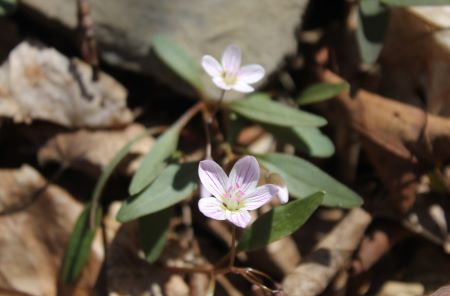By Bob Confer
While out and about in the forests of Allegany County in April and May, you will come across a dainty little wildflower called the spring beauty.
It is an attractive sprite that stands just two to four inches off of the ground. The flowers are only a half inch across. They are a very light pink or white (some even look like they were lightly brushed with lavender) and a closer inspection will show deeply-pink veins in the petals. Sprouting from inside the flower will be five or six stamens with pink tips. They are photo-sensitive, closing up and night and opening on the next sunny day (they remain closed on the cloudiest of days.)
The leaves are very narrow and typically two inches long in our northern woods – sometimes, in the best soils of Appalachia they will be much longer, sometimes reaching a half-foot in length. The leaves are shiny and smooth. Once the flowers wilt away in a couple of weeks, the leaves will remain with us until late-May.
The spring beauty is more than that cute flower. It’s what you don’t see that makes it even more of a special plant.
The flower’s underground root is a corm or tuber. They are very small, maybe no bigger than the fingernail on your pinky. They served the Native Americans quite well as a food source, although, as you can imagine, it would take some effort to harvest any reasonable quantity of the corm.
Spring beauty’s corms were treated like a small potato, hence another name for the flower – “fairy spud”. Native Americans used to roast them and it would have that same potatoey flower. Raw, they have a sharper flavor that some compare to a radish or chestnut.
More than just a foodstuff, some tribes also used them for medicinal purposes. They were used to treat children suffering from convulsions while others believed that if women ate them they could make themselves permanently sterile.
Those mystical powers have since been proven unfounded and the corm is classified as an edible and nutritious snack. Regardless, I suggest that you do not eat them – there’s no need to kill such a delicate, beautiful plant. Treat them well and their appearance will delight you every spring.






